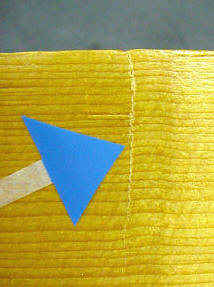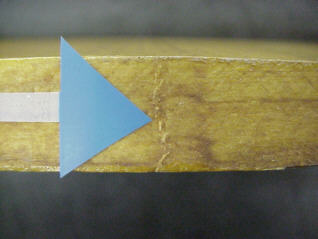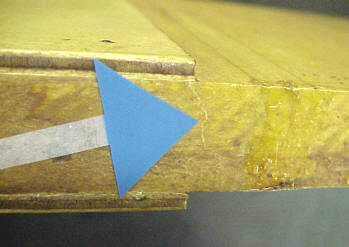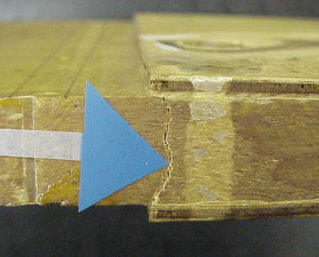A Very Disappointing Wing Spar Airworthiness Directive
(For those not familiar, an Airworthiness Directive (AD) is an order issued by the Federal Aviation Administration (FAA) to an aircraft owner to perform some task at their own expense. A Service Letter or Service Bulletin is issued by the aircraft manufacturer recommending an action, sometimes prompted by the FAA. A Notice of Proposed Rulemaking (NPRM) is issued by the FAA prior to an AD, and usually calls for a federally mandated period for public response.)
AD 2000-25-02 was published in the Federal Register as a final rule the week before Christmas. This is the all-encompassing high-wing wood spar inspection that has been kicking about since 1996, culminating in the 8GCBC Scout AD in 1998, now extended to all post-war Champion 7, 8- and 11-series aircraft. The FAA acknowledges the receipt of 'numerous' comments, but followed up with 'we do not concur' to almost all of these, in spite of their own request for comments and alleged high regard for the quality of same. No additional accident data was quoted, only an unspecified number of 'wing spar damage' reports in a review of the service history of the affected airplanes.
Some items of note:
1. Comment Issue No. 2 states 'the FAA has determined that wing damage incidents are the major cause of compression cracks and other spar damage in low horsepower and lightweight airplanes.. therefore a one-time inspection is acceptable...' but give no indication of in-flight causes in any of the affected fleet, nor a rationale for the differentiation. Why then impose a repetitive inspection on the rest of them?
2. Comment Issue No. 6 states 'we concur that maintenance manuals… and part 43 of the FARs specify inspecting the wing spars… However, this existing guidance does not provide instructions for sufficiently accessing the spar or identifying the damage.' * As we stated in our response to the NPRM, this guidance has been available all along, both in AC43-13-1B and ACAC Service letter 406A since May 1998. We have been publicizing, providing and encouraging their use ever since.
3. Comment Issues No. 8 & 9 'eliminate / minimize / require the installation of top inspection covers '. Here, at least there is no requirement to cut holes on top, but having included them as an option with reference to the service letters has had the effect of appearing to be mandatory; this was bought to our attention by calls from members complaining that their IA will not sign off without it. I understand that there are (at least) two legitimate points of view on this point. Given the fact that they are not necessary to accomplish the task, we strongly recommend against their installation due to the added level of risk they impose. There has been one call indicating that the positioning of these holes in SL417C is incorrect; we need further input on this.
4. Comment Issue No. 10 'commenter believes the cost of installing inspection covers will be significantly greater than we [FAA] estimated.. we infer that the commenter is referring to the additional costs associated with cosmetic paint refinishing… Cosmetic considerations are not reflected' . Hmm.. let's see. We only consider those costs we like, not those the owner needs to spend in order to bring the airplane back into service without warts. Two early estimates received by members indicate a cost almost double the FAA's $652 for the initial inspection. Not addressed at all were our comments regarding the significant depreciation of these aircraft due to the unwarranted AD.
5. Action. 'Inspect (detailed visual) the entire length of the front and rear wood spars' is a major change by stealth, as the original NPRM did not include those words. [On re-reading, SL406A says 'inspect full span along the front and rear wing spars', but only 'traditional methods' and applies only to the Sides/Ends portion.] How will all this be interpreted in the field?
6. Compliance Time. Convoluted nature of this requirement has resulted in dozens of calls to this office; our response has been to take a deep breath first and don't rush. Seems to us this AD will not be effective until January 19th [now past us], but will not be recognized as being complied with until the next Annual Inspection performed at least 30 days after that. Recap: If your Annual is due after February 19, 2001, then you must comply at that time; if you're due before February 19th then you can wait 13 months till the next one. [This on an AD the FAA considers to be life-threatening!] Since an Annual is not due until the end of the 12th month since the last one, we have no idea what to say to those who try to comply between February 1st and February 18th, except to wait until the 19th?! Wait, there's more. If you think you have already complied, since the methods and tools have been well known for some time and you have diligently followed both our long-time recommendations and methods pioneered by Carl Peterson, you are wrong. If you have recently replaced your wood spars (with new approved wood spars not metal) and had them recovered, painted and signed off, you still have not complied.
7. Reporting Requirements. This is the clause that had us wondering; if we have to inspect each year because the FAA has proof that they are about to break, why this stringent reporting requirement? A skeptic might get the impression that they are trying to justify this drastic action retroactively.
* I have come to the conclusion that the FAA is continuing on their path of micro-managing the maintenance of aircraft through regulatory edict, with total disregard for the input of mechanics and owners in the field. We were hoping for a more objective review, especially in light of the large number of thoughtful, studied and common-sense responses to the NPRM.
If you have opinions pro or con the above, we need to hear it. Your input, both technical and conceptual helps this Club develop a good integrated case either way, and good ideas from you will strengthen or modify our position. If you contact the FAA directly on this issue, please send a copy to this office as well.

Front Face of Spar
These failures are from about 5 inches inboard of the spar doubler plate. Note the differences in the face shots - one is much more subtle.

Rear Face of Spar
Also, note the wood grain anomaly (a subtle wave in the otherwise straight-line grain pattern) adjacent to the compression failure which is especially noticeable in the view on the rear of the spar. Without this grain anomaly, which acts to concentrate the stresses, there may not have been a failure at this location.

Top Surface of Spar

Top of Spar
Located at the inboard doubler plate, this is most likely what people will be looking for with their mirrors. It is subtle, but quite apparent if you know what to look for. It is jagged, not straight. A straight line is most probably only a scratch in the varnish. Note also that it does not go all the way across the top of the spar. Wouldn't want to do much acro with this.

Top of Spar
This is the Great Crevasse of Lynn. Located at the classic position, outboard end of the doubler plate. If you find this in your spar, it's the end of it. It should be noted that when this was still in the plane, it appeared much less obvious. The gap was tight, and opened up after the fabric was removed. The fabric was actually pulling things together.

